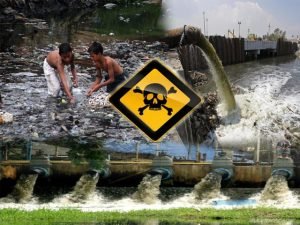
A wide variety of resources granted by nature are also using to retain and to develop life on this planet. Amongst them, water is a key element to support all kind of existence on this planet as one of the most dynamic human resources. Its preservation is, therefore, a priority. Since, it also has political, economic, social as well as ecological significance at world level. Moreover, the drinking water quality assurance regarding overall community health as being numerous health problems has become more significant and it can be resolved by make available safe drinking water free from contaminants like avirus, bacteria, metal ions, and minerals. Safe drinking water, as defined by the World Health Organization (WHO) Guidelines, does not represent any significant risk to health over a lifetime of consumption, including different sensitivities that may occur between life stages. Those at greatest risk of waterborne diseases are infants and young children, people who are debilitated and the elderly.
That’s why, currently, water pollution has arisen as a universal subject. Its pollution is also because of various pollutants having started to enter the aquatic systems due to swift industrialization and urbanization. In Pakistan, the potential sources as being contaminated fresh water systems are obviously emerging as the contaminated stream commencing from three foremost human being actions like agriculture, industrial and domestic zone. Moreover, comparison to agricultural and domestic practices, a series of industrial facilities like textile, tanneries, paper, mining operations, pesticides, pulp, food, beverages, metal plating, batteries, cement, pharmaceutical and fertilizers etc, having more pollutant amassing in their effluents, and ultimately releasing their grimy waste into open water stream without curing. Radioactive impurities, phosphate, personal care products, biodegradable waste, metal ions, injurious and risky substance, waste, sediments, are the main constituents of industrial effluents. Therefore, surface andsubsurface water contamination due to these organic and inorganic pollutants has an adverse environmental impact on whole ecological equilibrium.
Thus, a minute quantity of any perilous material could be a serious threat, especially to living biota. That’s why; wastewater pollution reduction is a most scorching concern in this current era. Most pollutants are non-biodegradable or recalcitrance in nature and encompassing supplementary lethal assets. Living tissues are more sensitive as their accumulation showing numerous infectivity and problems. For instance, in the category of metal ions, arsenic is most hazardous metal due to their moderately metal uniqueness. Cadmium is non-essential substance and their toxicity has been prolifically characterized to plant, animals, and humans. Their solemn detrimental consequence was categorized in the direction of bones, kidney and gastrointestinal harms, like diarrhea and vomiting and is most popular in producing itai–itai disease.Lead and mercury are the responsible for central nervous system annihilation, autoimmunity disorder (damaging of body cells). Moreover, liver, kidney, reproductive structure, brain functioning, mental illness and basic cellular problems are also caused by lead and mercury. A lot of hazardous symptoms as being hallucination, sleeplessness, muscles weakness, renal variations, anemia, irritability, are also commonly found.
A high dose of metal ions exposure could be a serious risk of brain setback (one can cause loss memory) and also keen negative blows, i-e organ infections, tumor diseases, lessening in maturity and development, central nervous system annoyance, however in harsh condition, demise. More exposure to metal ions, especially for children’s has been specified more rigorous as compared to adult’s one because of more food intake normalized to their body mass. Similar to inorganic chemical (metal ions), organic pollutant amassing has also been producing several health consequences. In organic pollutant contaminated water bodies, mostly pollutant destruction could be possible more quickly through demanding more dissolved oxygenand this state ultimately led to production of other secondary reason such as depletion of oxygen in relation to having anundesirable impact on whole ecological equilibrium.Another reason related to organically polluted water is, to prevent sunlight which is accessible to photosynthetic organisms, through covering whole liquid volume due to having huge quantity of recalcitrance compound and suspended solid especially.
Numerous hydrogen and carbon containing chemical compounds such as polychlorinated dibenzo-p-dioxins and dibenzofurans (PCDD/Fs), polychlorinated biphenyls (PCBs) and some dichloro diphenyl trichloroethane (DDT), dibenzo-p-dioxins(dioxins) and dibenzo-p-furans (furans) or some organo chlorine pesticides (OCPs), including hexachlorobenzene (HCB) are also known as persistent organic pollutants. All hydrocarbon, carbohydrates, pharmaceuticals, plasticizers, greases, biphenyls, oils, pesticides proteins, phenols, fertilizers, and detergents are fall in the category of organic pollutants. They can cause amore serious threat to the whole ecological equilibrium in a very minute concentration. Especially, persistent organic pollutants (POP’S) are of huge concern due to their lethal effects, long persistence in nature, and even amassing nature in living organisms and natural environment. They are non-biodegradable. These releasing compounds from wastewater into the surrounding environment can cause more threat to human beings and ecological environment.Consequently, due to having long persistence time and recalcitrance innature, their removal has become essential. Moreover, water pollution is more vigorously expanding in Pakistan via numerous facets. That’s why, environmental quality criteria by legislative authorities must be implemented, in order to resolve this dilemma in the direction of country people welfare and to ensure safe drinking water.
This article is jointly authored by Zeeshan Ajmal and Fouzia Irum.